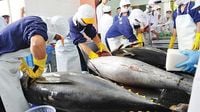Vietnam's shrimp industry is navigating through a complex landscape as it strives to maintain its competitive edge in the global market. In a recent development, U.S. President Donald Trump announced a 90-day delay in applying retaliatory tariffs on Vietnamese shrimp, a move aimed at facilitating negotiations that could impact the future of the industry significantly.
Despite economic challenges, Vietnam's shrimp exports soared to over 4 billion USD in 2024, marking a 14% increase from the previous year. Key provinces such as Ca Mau, Bac Lieu, and Soc Trang have been pivotal in this growth, with Ca Mau alone contributing 1.265 billion USD, Bac Lieu 1.210 billion USD, and Soc Trang over 900 million USD. The U.S. market accounts for approximately 20% of Vietnam's total shrimp export revenue, with values fluctuating between 800 million and 1 billion USD annually.
The looming threat of a 46% retaliatory tariff on Vietnamese shrimp imports into the U.S. raises concerns among local farmers and exporters. Although the tariff has not yet been implemented, the potential for it to remain after negotiations poses a serious risk to the industry. If the tariff is enacted, it could effectively close the U.S. market to Vietnamese shrimp, as local producers would struggle to compete against cheaper imports from countries like India and Ecuador.
Farmers are particularly worried about the rising costs associated with shrimp production. Reports indicate that feed accounts for about 60% of total production costs, and the prices for shrimp feed in Vietnam are significantly higher than in competing countries. For instance, Mr. Ta Hoang Nhiem, a shrimp farmer and chairman of the Bac Lieu Shrimp Association, noted that feed purchased through agents costs 40,000 VND per kilogram, while buying directly from the factory could reduce costs to just 27,000-28,000 VND per kilogram. This discrepancy can lead to an additional 700 million VND in expenses for farmers who cannot afford to purchase directly from manufacturers.
Moreover, the shrimp feed market in Vietnam is dominated by foreign brands, which control over 95% of the supply. This dependency on international suppliers has led to inflated prices, further squeezing the profit margins of Vietnamese shrimp farmers. As a result, many farmers find themselves in a precarious situation where they must incur debt to purchase feed on credit, only to face financial losses if shrimp prices fall.
In light of these challenges, experts are calling for a comprehensive restructuring of the shrimp industry to enhance sustainability and competitiveness. Pham Hoang Minh, director of the Bac Lieu High-Tech Agricultural Zone Management Board, emphasized the need for strategic policies that can help local farmers and businesses reduce costs and improve profit margins. He urged for a collaborative effort involving government agencies and industry stakeholders to develop a more resilient shrimp production model.
Meanwhile, the seafood sector as a whole has shown promising growth in early 2025, with total exports reaching 3.3 billion USD in the first four months, a 21% increase compared to the same period last year. Shrimp exports alone accounted for 1.27 billion USD, marking a significant 30% rise. This growth has been fueled by increasing demand from major markets such as China, the European Union, and Japan, as well as a recovery in global shrimp prices.
However, the U.S. market remains a critical focus for Vietnamese exporters. Despite a 7% increase in exports to the U.S. in the first four months of 2025, the impact of tariff policies and technical barriers continues to pose challenges. Exports to China and Hong Kong have surged, reaching 709.8 million USD, a 56% increase, while exports to Japan also experienced robust growth of 22%.
Interestingly, Vietnam's seafood exports to Russia are gaining momentum, particularly in the tuna segment. In 2024, exports to Russia reached nearly 45 million USD, a fivefold increase since 2020. The first three months of 2025 saw tuna exports to Russia surpassing 10 million USD, reflecting a growing partnership bolstered by favorable trade agreements.
As Vietnam's seafood industry continues to expand, it is essential for stakeholders to leverage trade agreements and explore new markets. The free trade agreement between Vietnam and the Eurasian Economic Union, which includes Russia, offers significant opportunities for both countries to enhance their trade relations.
In conclusion, the Vietnamese shrimp industry stands at a crossroads, faced with both challenges and opportunities. While the potential for retaliatory tariffs looms large, the resilience demonstrated by the sector in overcoming past hurdles offers a glimmer of hope. With strategic restructuring and a concerted effort from all stakeholders, Vietnam can not only safeguard its shrimp exports but also position itself as a leader in the global seafood market.

